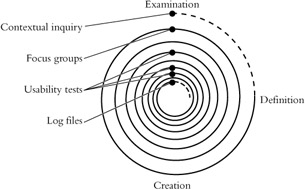Iterative Development and User Research
|
Iterative development is especially appropriate for Web-based products since prototypes can be made and evaluated quickly. Sculpturally, it's like working with plaster, clay, or wax before committing to stone or bronze. Changes can be put into effect rapidly, and release cycles can be arbitrarily tight. In the interest of rapid response, one search engine goes through a full iteration every week.
Unlike traditional software products, the immediate user experience presented by a Web site is critical. Usability has always been important, but in traditional software, the threat of instant abandonment didn't hang over every moment someone used the product. Moreover, since the user (or the company) had paid for the software and was planning to use it for extended periods of time, there was an incentive to make it work, so even a broken interface would be tolerated until a replacement was found. Such stability and loyalty are luxuries few Web sites enjoy. For the rest, the user experience needs to be right from the start.
User experience research need not be a part of iterative development. Iterative development can happen without any user research (for example, extreme programming is a highly iterative development process, but includes no explicit research component), and user experience research techniques can be used as part of any software development method. But the two work especially well together, where the results of one research project can answer questions asked by the ones before it and guide those that come after.
User research provides a consistent, rapid, controlled, and thorough method of examining the users' perspective. It appears at every rotation through the development spiral, providing a way of answering questions as they come up. Early on, background information about the users is gathered, the work they do is studied, and their problems described. Later on, features are prioritized in the order that people desire or need them. By the time that specifics are being nailed down, it's known which group of people want the product, what the product is supposed to do for them, and what is important for them to know and remember about it. When the details are designed and tested, it's known that the only thing that needs to be focused on is presentation rather than people's needs or product functionality because those have already been thoroughly researched. Graphically depicted, user research cuts through the development spiral, with different techniques appropriate at different times in a product's development. Figure 3.8 is a sample user research program, depicted as part of an iterative development spiral (the specific techniques will be discussed later in the book).

Figure 3.8: A sample research program.
|
EAN: 2147483647
Pages: 144